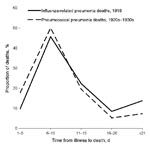Volume 15, Number 2—February 2009
Letter
Time from Illness Onset to Death, 1918 Influenza and Pneumococcal Pneumonia
To the Editor: Brundage and Shanks (1) have studied time to death from the onset of influenza symptoms during the 1918 pandemic in military and civilian populations and found a median time to death of 7–11 days. They argue that these data support the idea that the deaths may be predominantly due to bacterial superinfection after the acute phase of influenza. We observed a similar 10-day median time to death among soldiers dying of influenza in 1918 (2), a finding consistent with the time to death for a bacterial superinfection, specifically pneumococcal bacteremic pneumonia (3).
The major bacterial pathogen associated with influenza-related pneumonia in 1918 was Streptococcus pneumoniae (1,3). Neither antimicrobial drugs nor serum therapy was available for treatment in 1918. To further analyze the time course of death from influenza in relation to that of pneumococcal pneumonia in 1918, we examined data collected by Tilghman and Finland (4) from the pre–antimicrobial drug era of the 1920s and 1930s. The Figure shows the distribution of time from onset of illness to death due to influenza-related pneumonia in 1918 compared with time to death due to untreated pneumococcal pneumonia in the 1920s and 1930s. The Figure indicates a close concordance of the times to death. Similar times to death do not prove the specific bacterial etiology of the 1918 deaths. However, pneumococcal bacteremia was associated with most of the pneumonia deaths reported by Tilghman and Finland (4), and most 1918 influenza-related deaths were due to bacterial pneumonia (5). Also, up to 50% of patients dying from pneumonia in 1918 had pneumococcal bacteremia (3). These similar times to death provide additional evidence that the influenza-related pneumonia deaths during the 1918 influenza pandemic were largely due to the pneumococcus.
References
- Brundage JF, Shanks GD. Deaths from bacterial pneumonia during 1918–19 influenza pandemic. Emerg Infect Dis. 2008;14:1193–9. DOIPubMedGoogle Scholar
- Mills CE, Robins JM, Lipsitch M. Transmissibility of 1918 pandemic influenza. Nature. 2004;432:904–6. DOIPubMedGoogle Scholar
- Klugman KP, Madhi SA. Pneumococcal vaccines and flu preparedness. Science. 2007;316:49–50. DOIPubMedGoogle Scholar
- Tilghman RC, Finland M. Clinical significance of bacteremia in pneumococcal pneumonia. Arch Intern Med. 1937;59:602–19.
- Morens DM, Taubenberger JK, Fauci AS. Predominant role of bacterial pneumonia as a cause of death in pandemic influenza: implications for pandemic influenza preparedness. J Infect Dis. 2008;198:962–70. DOIPubMedGoogle Scholar
Figure
Cite This ArticleRelated Links
Table of Contents – Volume 15, Number 2—February 2009
| EID Search Options |
|---|
|
|
|
|
|
|

Please use the form below to submit correspondence to the authors or contact them at the following address:
Keith P. Klugman, Rollins School of Public Health, Emory University, 1518 Clifton Rd NE, Atlanta, GA 30322, USA
Top